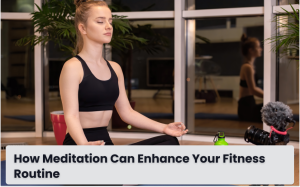
How Meditation Can Enhance Your Fitness Routine
A few years ago, I hit a plateau in my fitness journey. No matter how hard I pushed myself at the gym, my progress seemed stagnant. I was exhausted, stressed, and, truth be told, on the verge of quitting. That’s when I stumbled upon something I never thought could make a difference—meditation.
At first, the idea seemed odd. Meditation? For fitness? It felt out of place, but I decided to give it a try. What followed was nothing short of a transformation.
Let me take you on a journey to show how incorporating meditation into your fitness routine can revolutionize your workouts, just like it did for me.
The Day I Discovered the Mind-Body Connection

During one of my low-energy workouts, a trainer told me, “Fitness isn’t just about your body; it’s about your mind too.” Those words stuck with me. I started reading about the mind-body connection and came across stories of athletes using meditation to improve focus and endurance.
Curiosity got the better of me. One evening, before heading to the gym, I sat quietly, closed my eyes, and focused on my breath for five minutes. It was strange but calming. When I started my workout, something felt different. I was more present, more focused, and I moved with a rhythm I hadn’t felt in weeks. That day, I discovered the first benefit of meditation: mental clarity.
1. Mental Focus: The Game Changer
Meditation is known for its ability to enhance concentration and mental clarity. When you’re meditating, you’re practicing mindfulness, which is the art of focusing on the present moment without distractions. This mental discipline can translate to better focus during your workouts.
How It Helps:
- Enhanced Workout Performance: Staying present and focused during exercise helps you execute movements with better form and precision. Whether you’re lifting weights, running, or performing high-intensity workouts, mental clarity can improve your technique and reduce the risk of injury.
- Mindfulness in Movement: Meditation helps you become more attuned to your body, allowing you to notice imbalances, stiffness, or areas of weakness. This heightened body awareness can lead to more effective workouts as you make adjustments in real-time.
2. Reduced Stress and Anxiety
One of the most significant benefits of meditation is its ability to reduce stress and anxiety. Physical exercise can be mentally taxing, especially if you’re dealing with performance pressure, fear of failure, or even gym-related social anxiety. Stress also affects recovery and overall fitness progress.
How It Helps:
- Stress Reduction: Meditation lowers cortisol (the stress hormone), helping you manage pre-workout jitters and stay calm under pressure. Reducing stress can improve your endurance, allowing you to push through longer workouts.
- Improved Recovery: Since stress can interfere with the body’s natural recovery process, meditation aids in quicker recovery by promoting relaxation and reducing muscle tension.
3. Increased Endurance and Stamina
Meditation improves lung capacity and breathing efficiency, which can directly impact your endurance during cardio-heavy activities like running, cycling, or HIIT workouts. Breath-focused meditation techniques, such as pranayama in yoga, help you control your breathing, making it easier to maintain stamina during exercise.
How It Helps:
- Better Oxygen Flow: Mindful breathing techniques enhance oxygen delivery to your muscles, increasing endurance and stamina during intense workouts.
- Control Over Fatigue: Meditation helps you remain calm and focused even when your body is fatigued, allowing you to push your limits without becoming overwhelmed by the physical strain.
4. Enhanced Recovery and Healing
Recovery is a critical part of any fitness routine. The body needs time to heal and regenerate after intense physical activity, and meditation can accelerate this process by encouraging relaxation and reducing inflammation.
How It Helps:
- Reduced Inflammation:Studies show that meditation can reduce inflammation in the body, which is crucial for healing sore muscles after strenuous workouts.
- Improved Sleep Quality:Meditation can improve sleep, which is essential for recovery. Quality sleep allows the body to repair tissues, replenish energy, and grow muscle.
How to Integrate Meditation into Your Fitness Routine

The beauty of meditation is that it can be easily integrated into your fitness routine, regardless of your preferred workout style. Here’s how you can incorporate it before, during, or after your workout:
1. Pre-Workout Meditation
Meditating before a workout can help you center yourself and mentally prepare for the physical effort ahead. A short, 5-10 minute session focusing on deep breathing or a guided meditation can help you focus and reduce any pre-workout anxiety.
How to Practice:
- Find a Quiet Space: Sit or lie down in a quiet space, close your eyes, and take deep breaths. Focus on your breathing and let go of any distractions or stresses.
- Visualization: Imagine yourself successfully completing your workout, visualizing the movements, stamina, and effort you’ll put in. This can enhance your motivation and focus.
2. Mindful Movement During Exercise
During your workout, practice mindfulness by paying attention to how your body feels. Focus on the sensations in your muscles, your breath, and the rhythm of your movements. Mindful movement can make your workout more intentional and effective.
How to Practice:
- Be Present: Instead of letting your mind wander during your workout, focus on your breath and each movement you make.
- Control Your Breathing: Use deep, controlled breaths to maintain your energy and focus, especially during high-intensity or strength-based exercises.
3. Post-Workout Meditation
After an intense workout, meditation can help you cool down and relax. Post-workout meditation can aid in reducing muscle soreness and help your body transition from an active state to a restful one.
How to Practice:
- Body Scan Meditation: Lie down in a comfortable position and slowly direct your attention to different parts of your body, from your toes to your head, noticing any areas of tension or soreness.
- Deep Breathing: Practice deep, slow breaths to lower your heart rate and promote relaxation. Focus on calming your body and mind.
Benefits Backed by Science

Scientific research supports the positive effects of meditation on physical performance. A study published in the Journal of Sports Medicine and Physical Fitness found that athletes who practiced meditation experienced improved concentration, lower levels of anxiety, and enhanced physical performance compared to those who didn’t meditate. Additionally, research has shown that meditation reduces cortisol levels, which can lead to better recovery and a reduction in workout-related stress.
Summary
Meditation is more than just a mental exercise—it’s a powerful tool that can elevate your fitness game. From boosting focus and endurance to speeding up recovery, the benefits are undeniable.
If you’re ready to unlock your full potential, take a deep breath, start small, and watch how meditation transforms not just your workouts, but your life.




